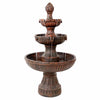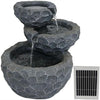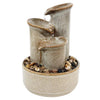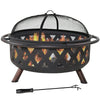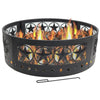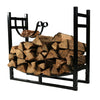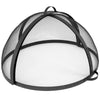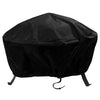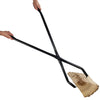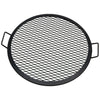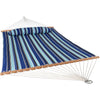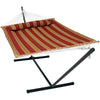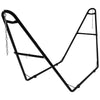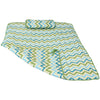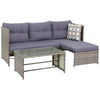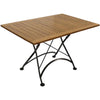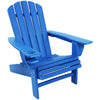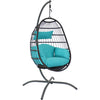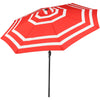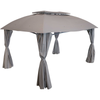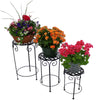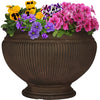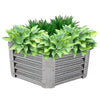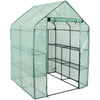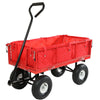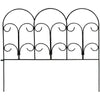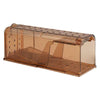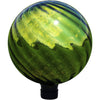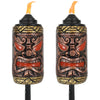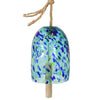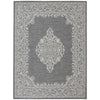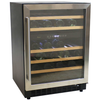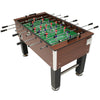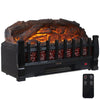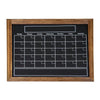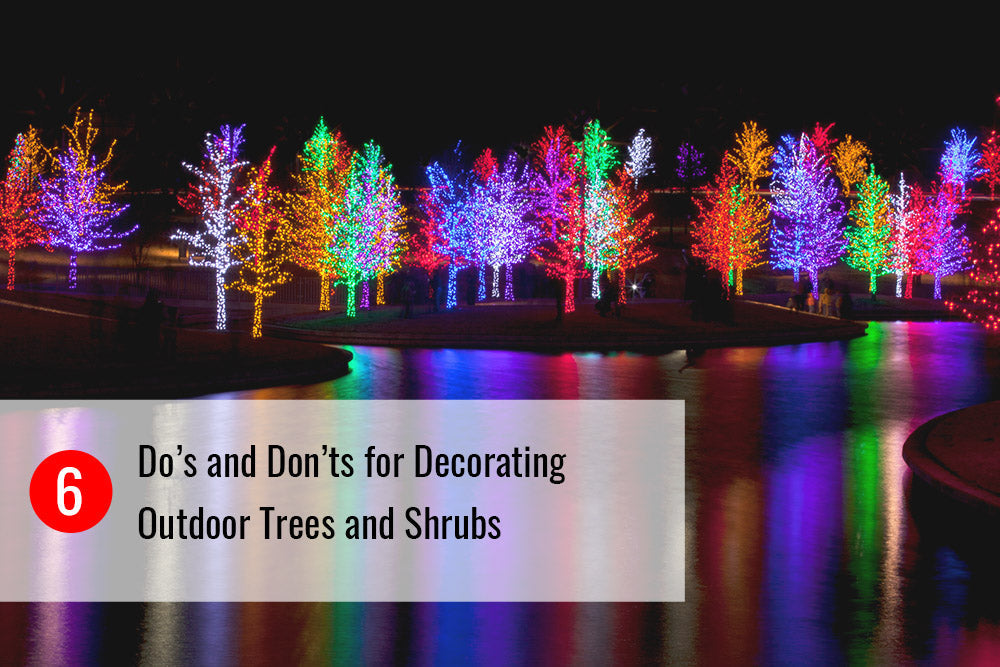Nothing beats relaxing outside on the patio on a warm day. However, too much summer sun can transform your pleasant day into a hot and miserable one. A patio umbrella is the perfect solution. Patio umbrellas provide refreshing shade and a stylish pop of color to any outdoor space.
But which patio umbrella is best for your space? Patio umbrellas are available in a variety of styles, materials, sizes, and shapes. Don’t worry! This buying guide will help you find the perfect patio umbrella for your space.
Information at a Glance
| Umbrella Type | Pole Material | Canopy Material | Size Range | Additional Features | Best Uses |
|---|---|---|---|---|---|
| Market Umbrella | Aluminum, Wood | Polyester, Sunbrella, Olefin | 7.5 to 10' Diameter | Canopy, Vent, Solar Lights, Tilt | Patio Dining Tables with Umbrella Hole |
| Offset Umbrella | Aluminum, Steel | Polyester, Sunbrella, Olefin | 9 to 10' Diameter | Canopy, Vent, Solar Lights, Rotation | Patio Sofa, Chairs, & Tables |
| Beach Umbrella | Aluminum, Steel | Polyester, Sunbrella, Olefin | 5 to 6' Diameter | Canopy, Vent, Tile, Staked Bottom | Beach Trips, Camping |
| Rectangular Umbrella | Aluminum, Steel | Polyester, Sunbrella, Olefin | 7' x 4' or 10' x 7' | Solar Lights, TIlt | Large Shade, Rectangular Tables |
Umbrella Styles
When most people picture a patio umbrella, they imagine a round or octagonal canopy with a center pole. This traditional design is certainly a popular option, but there are also a variety of other designs available. The best option depends on the set up of your patio and the area that you want to shade.

Market Umbrellas
The market umbrella style is one of the most popular umbrella designs available. These umbrellas feature an octagonal canopy and a center pole. They are typically used with patio tables that have a built-in hole for an umbrella. Market umbrellas usually require an umbrella base to stabilize it and keep it upright. They can be easily opened and closed by turning a crank handle or manually pushing the umbrella open.

Offset Umbrellas
Also known as cantilever umbrellas, offset umbrellas feature a pole that is located off to the side of the umbrella so the canopy extends out and over the area you plan to shade. This provides the shade you need without a center pole getting in the way. This design is great for shading patio seating like lounge chairs and outdoor sofas, hot tubs, and large patio tables that do not have an umbrella hole. Offset umbrellas can be easily opened and closed by turning a crank handle.
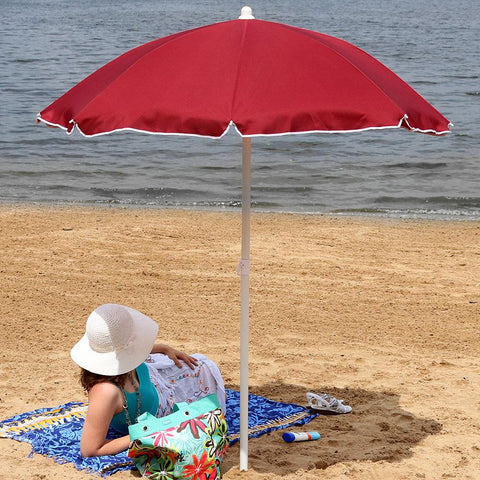
Beach Umbrellas
Beach umbrellas are lightweight and perfect for day trips. They can be easily transported and set up wherever you need a little extra shade. Beach umbrellas have stakes at the bottom of the poles so you can drive the pointed tip into the ground to stabilize the umbrella.
Wall Umbrellas
Wall umbrellas (also referred to as half umbrellas) resemble a market umbrella that has been split in half. They feature a half-moon-shaped canopy so the umbrella can fit snugly against a wall. Wall umbrellas are designed to be freestanding with the use of a base and can be easily opened and closed using a crank handle. These umbrellas are perfect for providing shade in small areas without the space for a full umbrella canopy.
Rectangular Umbrellas
Unlike other umbrella styles which feature a round or octagonal canopy shape, these umbrellas feature a rectangular canopy that is capable of shading large areas. Rectangular patio umbrellas are available in offset or market umbrella styles and are great for shading large, rectangular dining tables or large patio areas.
Patio Umbrella Fabric Types
The most noticeable element of a patio umbrella is its vibrant fabric canopy. These canopies are available in a number of unique colors and patterns to complement any patio decor, but there are also a variety of materials to choose from as well.
Polyester
Polyester is one of the most popular canopy materials available. This synthetic material is solution dyed which means that the color is added to the fibers when they are still in a liquid state. This allows the material to be dyed in a variety of unique and long-lasting colors. Polyester is also highly resistant to wrinkling and easy to clean and maintain. This material is resistant to fading and able to retain its shape over time, but it is still recommended to store polyester umbrellas indoors when not in use.
Olefin
Olefin is another synthetic material that is lightweight and dries quickly. Like polyester, olefin is solution dyed so it features lasting color and is available in a variety of shades and patterns. Olefin is also environmentally friendly because few byproducts are created during the production process, and this fabric can even be recycled.
Sunbrella
Sunbrella is a specialized fabric that is designed for outdoor use. It is commonly used for patio umbrellas, outdoor furniture, and outdoor throw pillows. This durable fabric features UV protection and is highly resistant to stains and mildew. This ensures that the color and material will last season after season.
Frame Material
Another umbrella material that you need to consider is the umbrella frame. The frame of the umbrella refers to the pole that supports the umbrella as well as the ribs, small slender pieces that hold the canopy open. The frame provides the structure needed to support the umbrella.
Wood
Wood umbrella frames are typically made from hardwoods like teak, bamboo, or eucalyptus. Umbrellas with a wood frame have a sophisticated appearance that complements a variety of decor styles. Wood is prone to fading over time so it is recommended that you store the umbrella indoors when not in use.
Metal
Aluminum or steel frames are lightweight but sturdy and require very little maintenance. Plus, metal umbrella frames can be powder-coated in a variety of colors for a lasting finish that will complement any patio furniture.
Fiberglass
Fiberglass is the most durable umbrella frame option on the market. Due to their sturdy construction, light weight, and flexible design, these frames are highly wind- and water-resistant for a long-lasting product life.
Patio Umbrella Sizes
| Shade Area | Recommended Canopy Size |
|---|---|
| 30 Inches and Under | 5 to 6 Feet |
| 30 to 36 Inches | 6 to 8 Feet |
| 36 to 48 Inches | 8 to 9 Feet |
| 48 to 60 Inches | 9 to 10 Feet |
| 60 to 72 Inches | 10 to 11 Feet |
| 72 to 84 Inches | 11 to 12 Feet |
| 84 to 96 Inches | 12 to 13 Feet |
| 96 to 108 Inches | 13 to 14 Feet |
Patio Umbrella Features
Certain patio umbrellas also have useful features to improve your outdoor experience. These features can vary by the model and style of the umbrella.
Ventilation
Select patio umbrellas feature a vent in the canopy of the umbrella. Ventilation helps keep the umbrella stable in windy conditions by providing a release for the air so the canopy cannot fill with air and blow away. The vent also helps prevent heat from getting trapped underneath the canopy. Heat rises and escapes through the vent keeping your area cooler.
Tilt
The tilt feature is a convenient option for center pole umbrella styles that allows you to adjust the angle of the canopy. This ensures that you receive the perfect amount of shade.
360-Degree Rotation
Rotation is a useful feature for off-set umbrellas. This allows the umbrella to turn 360 degrees so you can position the canopy directly over the area you want to shade without having to move the entire umbrella.
Solar Lights
Select market and offset umbrellas feature solar-powered lights along the ribs of the umbrella. A solar panel is positioned on top of the umbrella which charges the battery that powers the lights. Once the sun sets, you can turn on the lights to illuminate your outdoor space.
Choosing a Patio Umbrella Base
It’s important to ensure that your umbrella is properly weighted to stay upright. The type of base required depends on the style and size of the umbrella. The larger the umbrella, the heavier the weight needs to be.

A market umbrella requires an umbrella base stand. To determine how heavy the umbrella needs to be, take the diameter of the umbrella canopy and multiply it by 10. That number will tell you how many pounds the umbrella base needs to be. For example, a 9-foot umbrella will require a 90-pound umbrella stand. You must also measure the inner diameter of the neck (the part of the stand where you will place the umbrella pole). Make sure that the inner diameter of the neck is wide enough to accommodate the pole of the umbrella.
Wall umbrellas also require a base stand. Like their canopies, wall umbrella base stands feature a distinct half-moon shape that allows you to press the base against the wall in order to save space.
Offset umbrellas on the other hand use a series of four weights that are filled with sand or water and then are placed around the cross frame base of the offset umbrella to securely weigh it down.
For additional tips on making sure your patio umbrella stays upright, check out our article, 7 Ways to Keep Your Patio Umbrella From Falling Over.
Additional Patio Umbrella Accessories

There are a variety of other convenient accessories that you can add to your umbrella to help create a pleasant place to relax outdoors. LED umbrella lights can be attached to an umbrella by clipping the unit around the pole of the umbrella. An umbrella table is another convenient accessory that can be used with beach umbrellas. Simply attach the table to the pole of the umbrella for a convenient surface as you relax beneath the umbrella.
Select the Best Patio Umbrella for Your Needs
No matter what style or color you choose, you’re sure to love spending time beneath the canopy of a beautiful patio umbrella. They’re the perfect centerpiece for your patio as well as a refreshing place to escape the heat of the sun.
To keep your patio umbrella looking brand new season after season, check out our article, How to Clean a Patio Umbrella So It Looks (Almost) Brand New.
